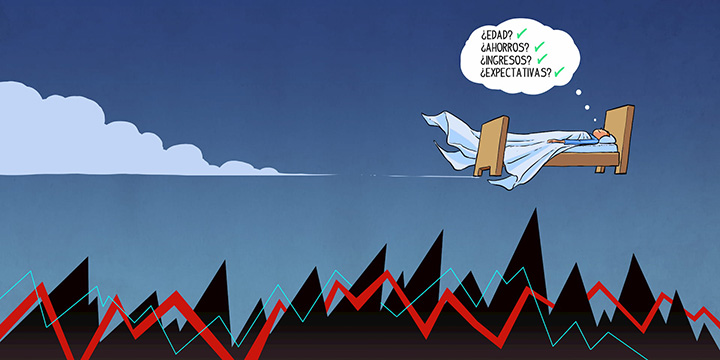Investing is not an obligation. At least, that’s what we should bear in mind when thinking about what to do with our savings.
However, isn’t it tempting when a friend, neighbor or even that family member who’s always going on about their investments on the stock exchange advises us to invest in a product he’s been recommended, and which promises huge returns?
Investing should be the result of a carefully considered decision. This can’t be emphasized enough. And particularly when investing in equities. Here there’s no room for promises or guarantees, but it is worth taking a look at history.
This was demonstrated by Jeremy Siegel with his famous graph of the evolution of returns over a little more than 200 years depending on the type of assets in which the investment was made. One dollar invested in stocks in 1802, became 1,033,487 dollars, whereas the same investment in bonds or treasury bills became 1,642 and 275 dollars, respectively.
This evidence on stocks is certainly tempting, and actually quite attractive, isn’t it? But be careful! You have to be fully aware of what it means, and before making a move it’s a good idea to know what to do when you’re investing on the stock market.
The first thing you need to ask yourself is whether you are absolutely sure. If you have any concerns or doubts, the best option is not to do anything. The short-term ups and downs in the market can make us hesitant and – in the worst case – can scare us off. Precisely the main work of the investor relations team in an investment management company consists of dispelling the fear of the unknown through information and vast amounts of knowledge. As our beloved Warren Buffett once said: “Risk comes from not knowing what you’re doing”.
Once you’re sure that equity can maximize your savings in the long term, the second question to ask would be: “What is my savings capacity?” To materialize the investment, the first thing you need is to achieve savings. If you don’t think to have the capacity for it, you should remember a good old Spanish saying: “The richest man is not who has the most, but who needs the least”. The key lies in planning the money that comes into your household and from the first day of the month, trying to save and set aside for investment the amount you calculate you aren’t going to need, having previously estimated a “cushion”.
“How long should I invest?” This is the third question, as the greatest mistake when investing in the stock market is not having a clear time horizon. When the markets fall, the chances you’ll conserve your capital and – above all – be able to make a profit on it will be greater over the longer term. This is the big difference between risk (buying a share that has financial problems or is overvalued) and volatility (an opportunity when the market punishes a quality share that has a high potential for revaluation).
Finally, “How to invest?”. By buying shares either yourself or through a trustworthy investment management company. The first option is a little complicated as you could be investing with insufficient knowledge. When deciding to trust a management company, it’s very important to know who’s in charge, to go through its past history and professionalism very closely and especially, to find out everything you can about its process.
I To avoid sleepless nights
After these reflections, you might feel ready to try your hand at INVESTING. Above I mentioned that we sometimes get carried away by the advice of an acquaintance. But it’s very important to know yourself first so you’ll feel comfortable with the money invested and the product you choose. In short, I call it “avoiding those sleepless nights”.
For example, when we buy a car, many of us go through a hypothetical questionnaire to ensure we get what we want: whether we like speed or not, if we need a car for the city or for the road, diesel or gasoline… And yet many people planning to invest on the stock market only ask the question “What do you expect from this investment?” with the answer: “Making a huge amont of money in a very short time”. Big mistake.
So in order to avoid disappointment, we should do the same exercise as if we were buying a car: ask ourselves a series of questions. It would even help to write them down.
- How old am I?
- What’s my family situation in relation to income?
- How much of my savings do I need in the short term?
- What are my expectations in terms of my work situation?
- What products am I most familiar with and what knowledge do I have about them?
- How would I respond to a 30% drop in the stock market?
The answers to these questions will give us a good idea of where we stand in regard to investments, and we’ll be ready to have a good conversation with an expert who can give us information on the products that best fit our profile and what rate of return can be expected.
So invest only what you don’t need. Do your research and find out as much as you possibly can. Make sure you have an in-depth knowledge of what you’re investing in or the people you’re trusting to invest for you, without worrying about the ups and downs of the market. And finally, learn what type of investor you are.
In short, know yourself and you’ll be guaranteed a good night’s sleep.
Did you find this useful?
- |







